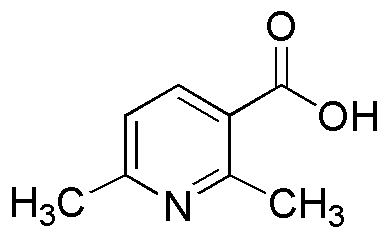2,6-Dimethylnicotinic acid is widely utilized in research focused on:
- Pharmaceutical Development: This compound serves as a key intermediate in the synthesis of various pharmaceuticals, particularly those targeting neurological disorders, enhancing drug efficacy and specificity.
- Agricultural Chemistry: It is used in the formulation of agrochemicals, including herbicides and pesticides, contributing to improved crop protection and yield.
- Biochemical Research: Researchers employ it in studies related to enzyme inhibition and receptor binding, aiding in the understanding of metabolic pathways and disease mechanisms.
- Material Science: The compound is explored for its potential in developing novel materials, such as polymers and coatings, which offer enhanced durability and chemical resistance.
- Flavor and Fragrance Industry: It is also utilized in the formulation of flavoring agents and fragrances, providing unique sensory profiles that appeal to consumers.
General Information
Properties
Safety and Regulations
Applications
2,6-Dimethylnicotinic acid is widely utilized in research focused on:
- Pharmaceutical Development: This compound serves as a key intermediate in the synthesis of various pharmaceuticals, particularly those targeting neurological disorders, enhancing drug efficacy and specificity.
- Agricultural Chemistry: It is used in the formulation of agrochemicals, including herbicides and pesticides, contributing to improved crop protection and yield.
- Biochemical Research: Researchers employ it in studies related to enzyme inhibition and receptor binding, aiding in the understanding of metabolic pathways and disease mechanisms.
- Material Science: The compound is explored for its potential in developing novel materials, such as polymers and coatings, which offer enhanced durability and chemical resistance.
- Flavor and Fragrance Industry: It is also utilized in the formulation of flavoring agents and fragrances, providing unique sensory profiles that appeal to consumers.
Documents
Safety Data Sheets (SDS)
The SDS provides comprehensive safety information on handling, storage, and disposal of the product.
Product Specification (PS)
The PS provides a comprehensive breakdown of the product’s properties, including chemical composition, physical state, purity, and storage requirements. It also details acceptable quality ranges and the product's intended applications.
Certificates of Analysis (COA)
Search for Certificates of Analysis (COA) by entering the products Lot Number. Lot and Batch Numbers can be found on a product’s label following the words ‘Lot’ or ‘Batch’.
*Catalog Number
*Lot Number
Certificates Of Origin (COO)
This COO confirms the country where the product was manufactured, and also details the materials and components used in it and whether it is derived from natural, synthetic, or other specific sources. This certificate may be required for customs, trade, and regulatory compliance.
*Catalog Number
*Lot Number
Safety Data Sheets (SDS)
The SDS provides comprehensive safety information on handling, storage, and disposal of the product.
DownloadProduct Specification (PS)
The PS provides a comprehensive breakdown of the product’s properties, including chemical composition, physical state, purity, and storage requirements. It also details acceptable quality ranges and the product's intended applications.
DownloadCertificates of Analysis (COA)
Search for Certificates of Analysis (COA) by entering the products Lot Number. Lot and Batch Numbers can be found on a product’s label following the words ‘Lot’ or ‘Batch’.
*Catalog Number
*Lot Number
Certificates Of Origin (COO)
This COO confirms the country where the product was manufactured, and also details the materials and components used in it and whether it is derived from natural, synthetic, or other specific sources. This certificate may be required for customs, trade, and regulatory compliance.


